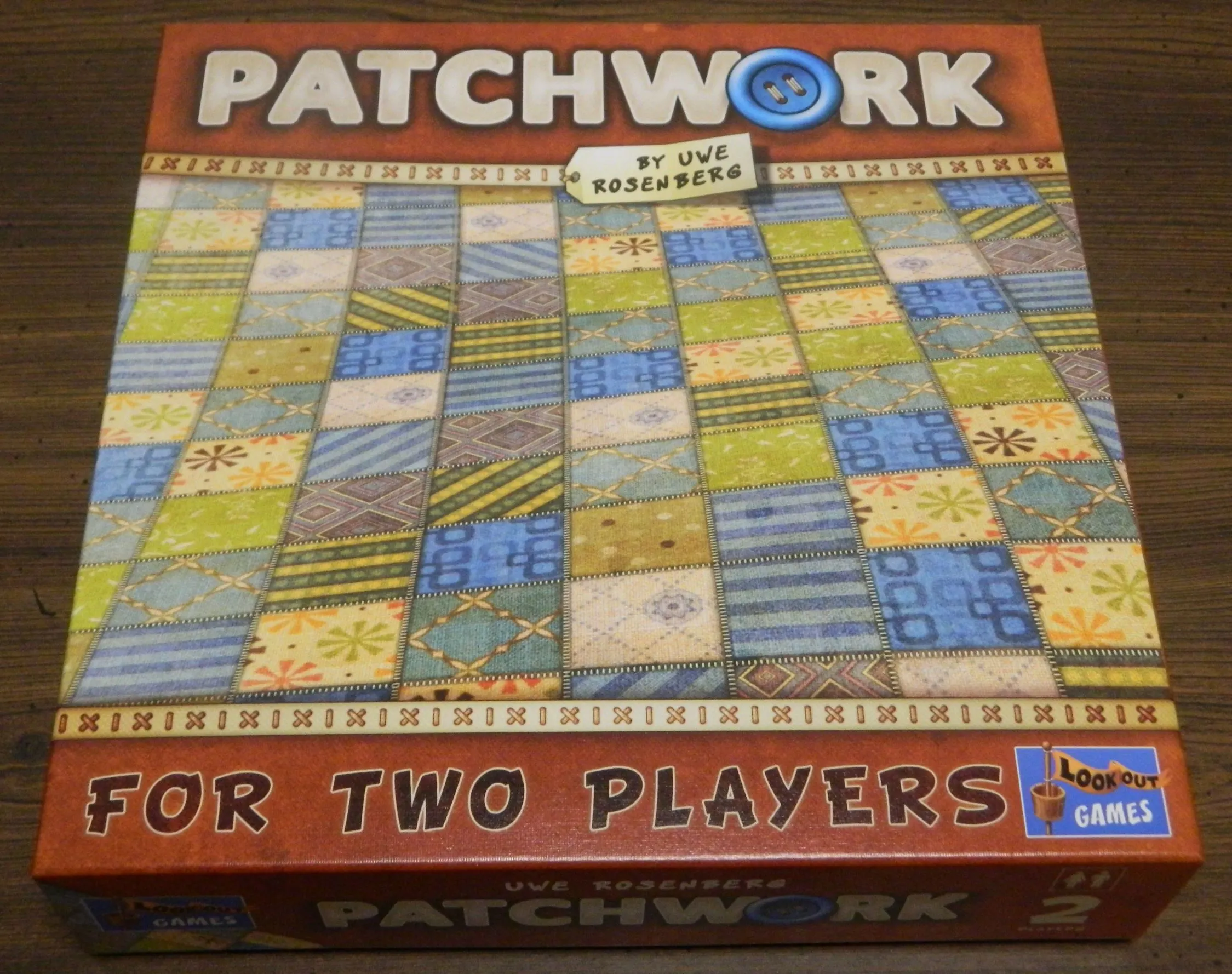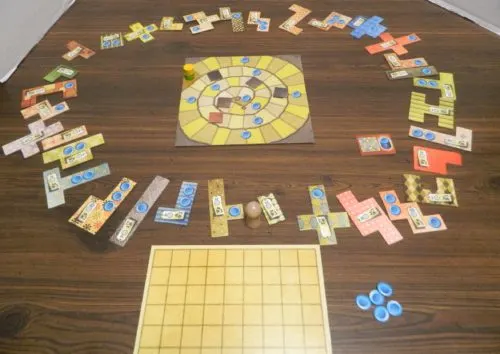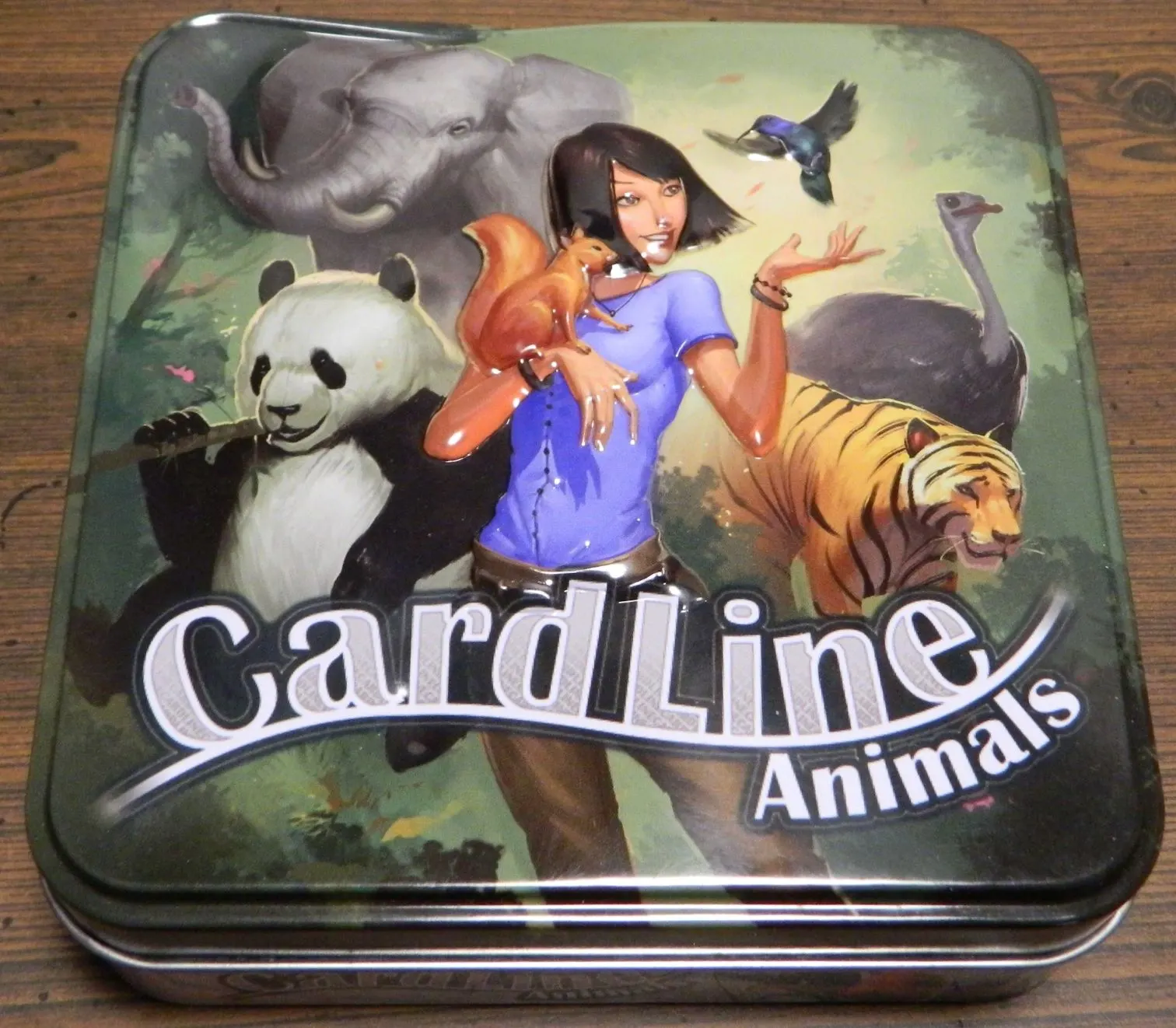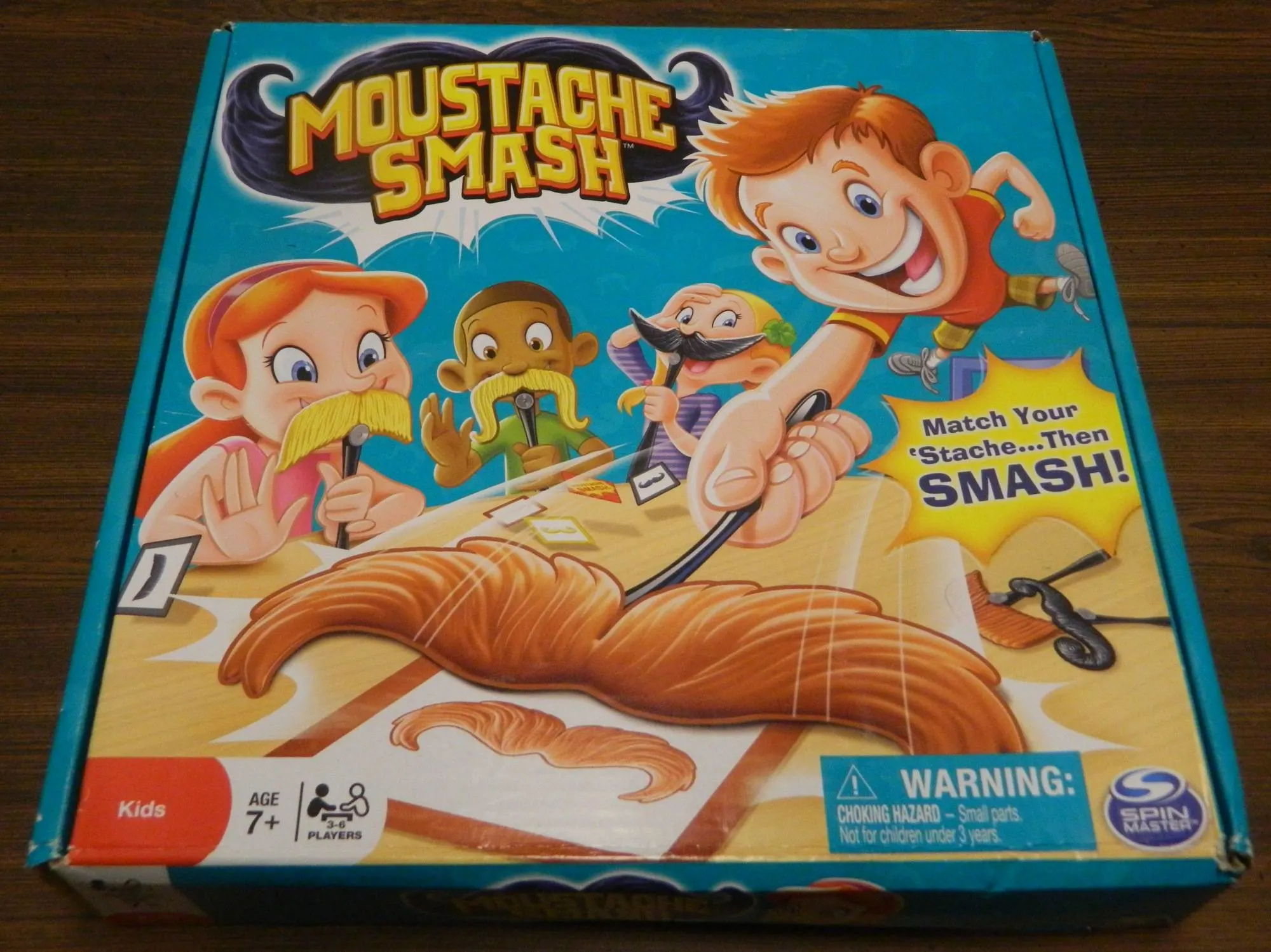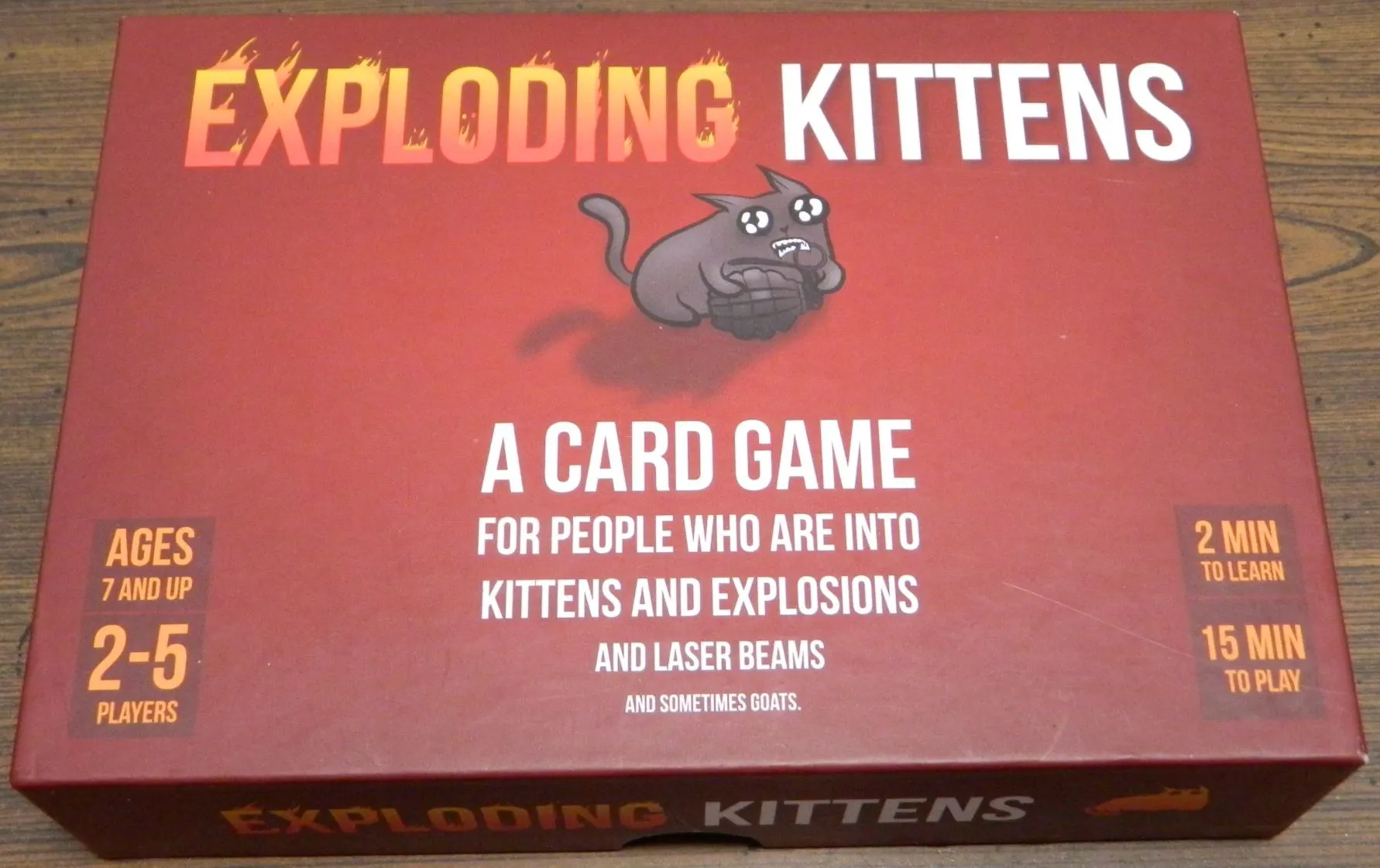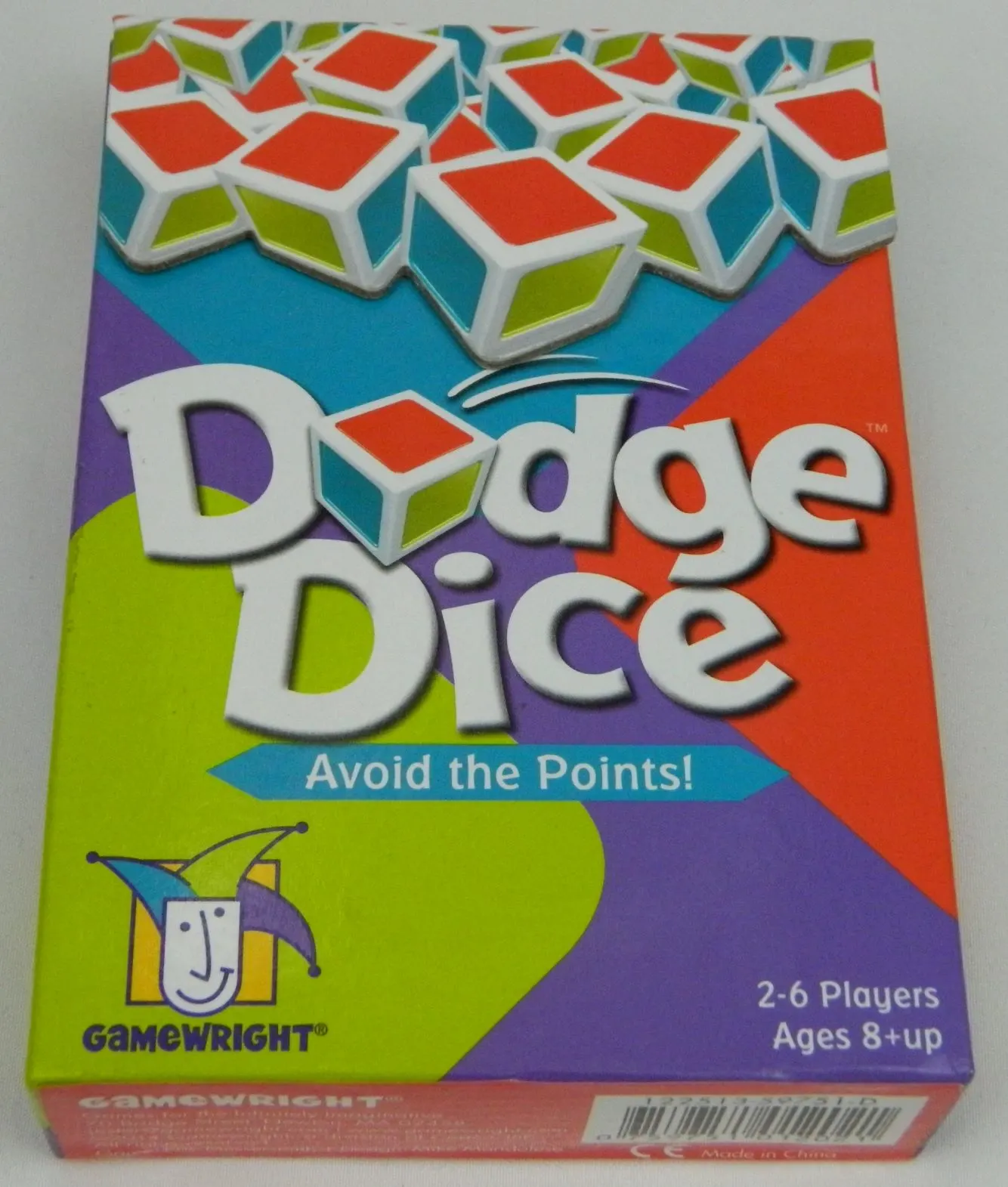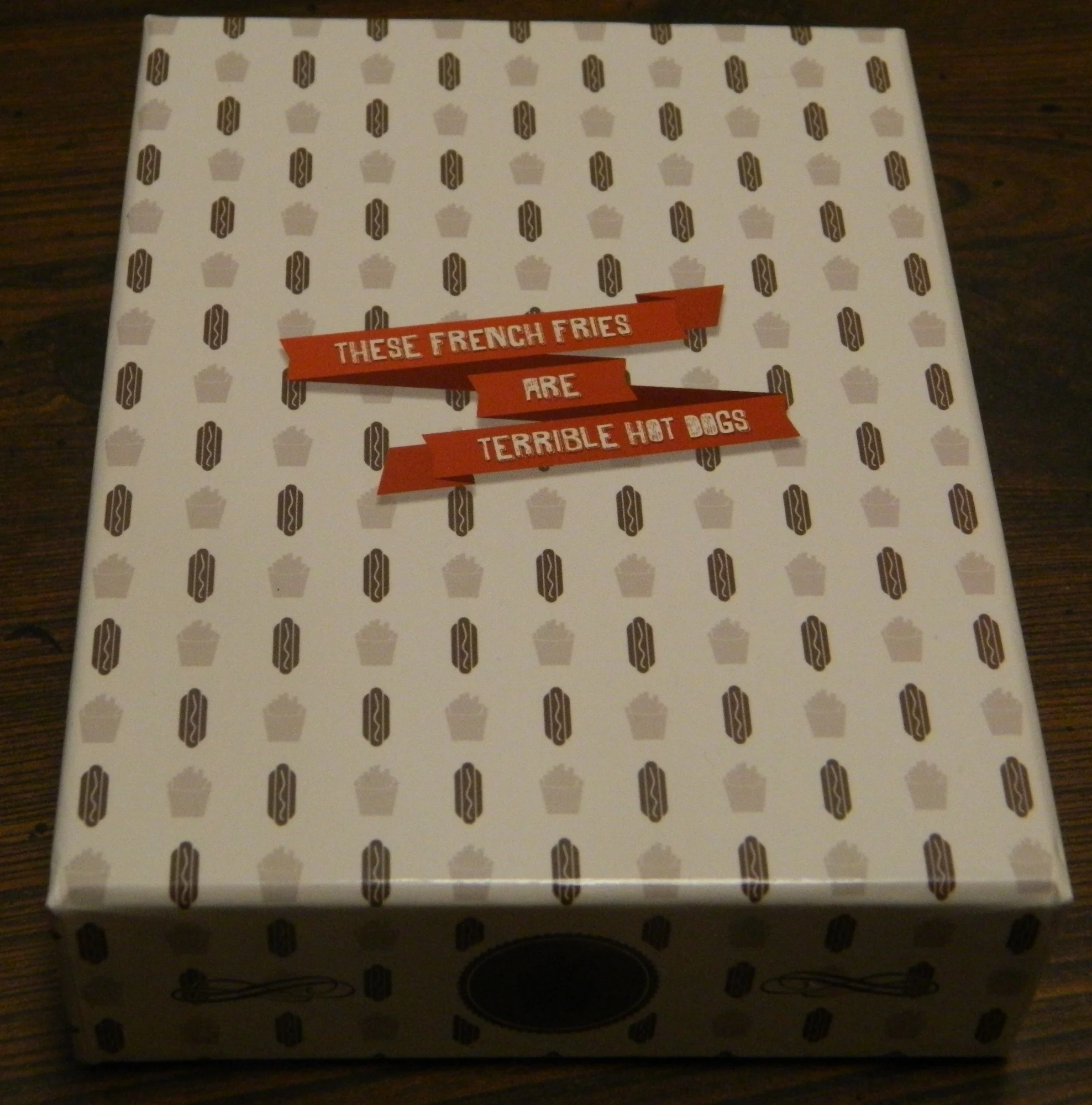Rated as one of the top 100 board games of all time on Board Game Geek, Patchwork is a game that I have been looking forward to playing for quite some time. With how many board games that have been created, it is quite impressive to be rated as one of the best board games of all time. It is not all that surprising as the game was designed by Uwe Rosenberg who has a long track record of creating great board games. While it might not appeal to everyone I thought the idea of designing a board game around making a quilt was also a really interesting idea. When you add in that I really like tile laying games it is not surprising that I was really excited to try out Patchwork. It might be a little overrated due to its reliance on luck, but Patchwork is a fantastic two player game that packs so much into such a simple game.
How to Play Patchwork
Setup
- Each player will take a quilt board, a time token and five buttons. Each player places their quilt board in front of them.
- The buttons not given to the players form the bank. Set aside the special tile as well (shows 7 x 7 on it).
- Place the time board in the center of the table. You can choose which side you want to place face up as the only difference between the two sides is cosmetic.
- Each player places their time tokens on the start space.
- Randomly place the patches in a circle around the time board. Find the smallest patch (2 x 1) and place the neutral token to the left/clockwise of it.
- Place the special patches (1 x 1) on the corresponding spaces on the gameboard.
- The last player to use a needle will start the game.
Playing the Game
The current player is determined by whose time token is further back along the time board. This means that a player can end up taking several turns in a row. If both tokens are on the same space the token on top of the other token will get to take the next turn.
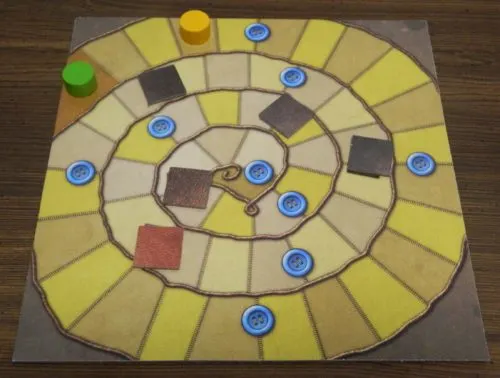
The green player will take the next turn as they are further back on the track than the other player.
On a player’s turn they can take one of two actions:
- Advance Your Time Token and Receive Buttons
- Take and Place A Patch
Advance Your Time Token and Receive Buttons
If a player chooses this action they will move their time token to the space in front of the other player’s time token. They will receive one button from the bank for each space that they moved their token.
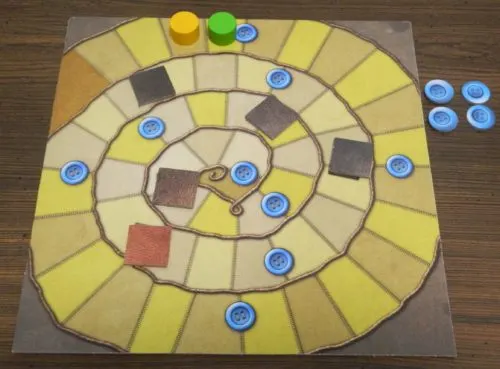
The green player has decided to move their pawn past the yellow player’s pawn. Since they moved their pawn four spaces, they will collect four buttons from the bank.
Take and Place A Patch
The other option that a player can take involves purchasing a patch and placing it on their quilt board. To purchase and place a patch you must follow these steps.
First you will choose which patch you would like to purchase. You may only purchase one of the three patches clockwise from the position of the neutral token. After you have chosen a patch to purchase you will move the neutral pawn to the space that the chosen patch occupies.
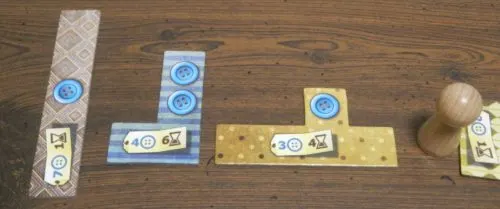
On this turn the player can purchase one of these three tiles to the left of the pawn. The first tile will cost three buttons, the second tile four buttons, and the third tile seven buttons.
The player then pays the amount of buttons shown on the patch to the bank.
Once the patch has been purchased it will be placed on the player’s quilt board. You can twist and turn your patch in any way you desire before placing it on your quilt board. You can place the patch anywhere on your board as long as all of the spaces of the patch fit on your quilt board and don’t overlap other patches already on the board.
The player will then move their time token forward the number of spaces indicated by the hour glass on the patch they just added to their quilt board. If your time token lands on the same space as your opponent’s token, you will place your token on top of theirs.
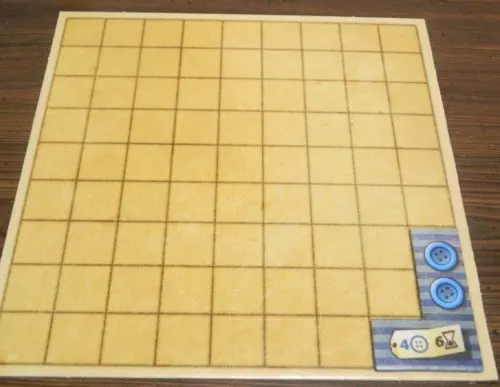
This player has added their chosen tile to their gameboard. As the tile shows a six next to the sand timer, the player will move their playing piece forward six spaces.
Special Spaces
As you move your time tokens around the gameboard you will occasionally pass special spaces on the board. Whenever you pass one of these spaces you will take the corresponding action.
The first player to pass a special patch space will take the patch from the gameboard. They will then place the patch somewhere on their board.
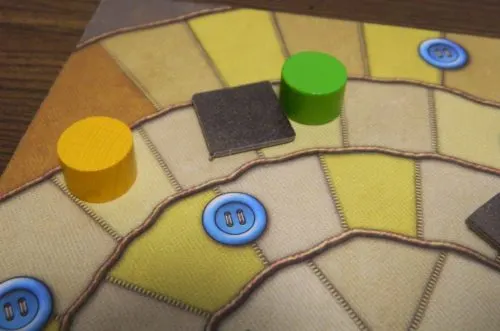
The green player has moved past the patch space. They will take the patch and add it to their quilt.
When a player passes a button space they will earn coins from the bank.
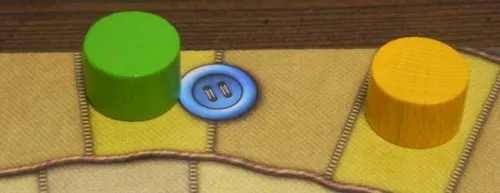
The yellow player has moved past a button space on the gameboard. They will receive buttons from the bank depending on the number of buttons in their quilt.
The player will count up how many buttons are on the patches currently on their quilt board. The player will receive one button from the bank for each button currently in their quilt.
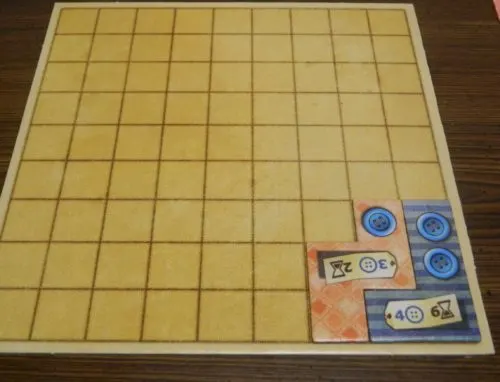
This player has three buttons in their quilt. They will receive three buttons from the bank when they cross a button space on the gameboard.
The Special Tile
The first player to completely fill (with no empty spaces) a 7 x 7 grid on their board will receive the special tile. This special tile is worth seven points at the end of the game.
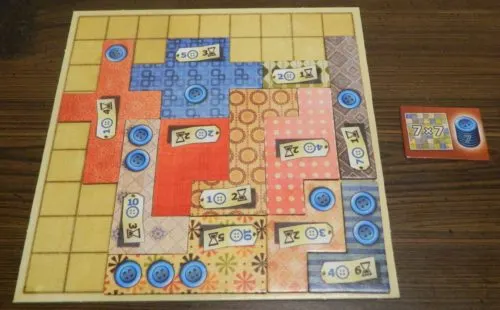
This player has successfully filled in a 7 x 7 grid on their gameboard. They will receive the special 7 x 7 token.
End of Game
A player’s game will end when their pawn reaches the last space on the gameboard. The game will end when both players reach this space. If for your last action you advance your time token instead of purchasing a tile, you will only receive buttons for the spaces that your time token actually moved.
Players will then count up their score. The players will count up how many buttons they currently have. The player who acquired the special tile will add seven points to their total. Players will then subtract two points from their score for each space on their board that wasn’t filled in. The player who scores more points will win the game. If there is a tie the player who reached the finish first will win the game.
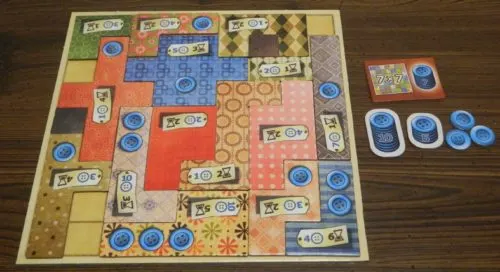
This player will score the following amount of points. They will score 18 points for their remaining buttons. They will score seven points for the 7 x 7 token. They will lose eight points for the four spaces in their quilt that weren’t filled in. They will score a total of 17 points.
My Thoughts on Patchwork
Before playing Patchwork I didn’t know what to expect out of the game. Uwe Rosenberg is a great board game designer, but a lot of his most popular games are on the more difficult side of the spectrum for board games. While it looked like a typical tile laying game, I was curious about how difficult Patchwork would be. After playing Patchwork I don’t know if I have ever played a game that has fit so much into such a simple game.
I have to say that I was genuinely surprised by how easy Patchwork was to play. The game is so simple because you only have to choose from two different options on your turn. Both of these actions are quite straightforward where you shouldn’t have any troubles figuring out what you should do. You could honestly teach Patchwork to new players within a couple minutes. The game has a recommended age of 8+ which seems about right. With the game being so simple it can appeal to people that don’t play a lot of board games.
Patchwork’s simplicity also leads to the game playing pretty quickly. I would say that most games should only take around 20-30 minutes. This length feels perfect for the game for a couple reasons. First it makes Patchwork a great filler game. If you don’t have a lot of free time or need something as a break between longer games, Patchwork is the perfect game for you. The other reason I liked the shorter length is that it makes it easy to quickly play a rematch. You very likely will want to play a rematch as Patchwork is the type of game that you don’t want to put down..
While Patchwork only has two different actions that you can take on your turn, there is still quite a bit of strategy in the game. Your decisions in the game will make a big difference in the outcome of the game. If you make bad decisions you will have a hard time winning the game. Usually the correct action to take at any given time is pretty obvious. There are quite a few times though where you have to make a crucial decision. For how simple the game is, Patchwork has a surprising amount of strategy. The strategy is really accessible though and is pretty straightforward where you don’t have to worry too much about analysis paralysis.
I think the strategy of Patchwork works so well as the decisions it presents you with are quite clever. The first decision you will make on each turn is whether you will move your piece forward or purchase a new tile. When you decide to move your pawn forward you are basically giving up one or more turns in order to receive some buttons (money). How turn order is determined in Patchwork is quite clever. Instead of players taking turns, the player further behind on the track will get to take the next turn. This could lead to one player taking multiple turns in a row. You don’t want to ever get too far ahead of another player so you have to consider this when purchasing tiles. If you get way ahead you will either give the other player a lot of buttons if they choose to move their pawn past yours or you will give the other player multiple turns in a row.
If you choose to purchase a tile the game gives you quite a few things to consider. I basically would break the tiles into three groups. The first group are the tiles that feature buttons. These tiles are pretty expensive as they will give you buttons throughout the game. Next are the small tiles with more basic shapes. These tiles don’t fill up a lot of spaces but they are good to use to fill in gaps in your quilt. Finally there are the large tiles that fill up a lot of spaces. These tiles are hard to place in your quilt but they will help by filling in a lot of spaces. These three types of tiles have differing values throughout the game, but each type has their own positives and negatives.
While I am far from an expert at Patchwork, it does seem like there is a basic strategy that you should probably try to follow.
At the beginning of the game you probably want to focus on acquiring tiles that have at least one button on them. It is important to acquire tiles with buttons on them early or you will be limited on what tiles you can purchase later in the game. You can only acquire buttons in two ways and you need buttons in order to purchase tiles. First you can move your pawn past the other player’s pawn which will give you buttons based on how many spaces you move your pawn. Choosing this option though requires you to give up opportunities to purchase tiles. Otherwise you can purchase tiles with buttons on them and place them in your quilt. You will then receive buttons each time you pass a button space on the gameboard. This is a more sustainable strategy as it will give you buttons throughout the game and you don’t have to forfeit turns. The earlier you place buttons in your quilt the more buttons you will receive throughout the entire game as you will collect them more often.
After you add a decent amount of buttons into your quilt you want to shift your attention to purchasing larger tiles. Some of these large tiles can be weird shapes or hard to fit into your quilt but they are worth adding if you can fit them. The reason why the large tiles are key is that they are a good return on your money. Due to them being large and hard to fit into your quilt, they are quite cheap for how many spaces they fill in your quilt. If you want to fill up a large percentage of your quilt board you will need to place these tiles onto your board. While the smaller pieces are easier to place in your quilt, they don’t fill up nearly as many spaces in your quilt.
As you approach the end of the game you want to purchase tiles that fit the best in the remaining spaces on your quilt board. In order to do well in the game you need to do a good job filling in most of the spaces on your board. As each space you don’t fill in costs you two points, empty spaces add up quickly. If you leave a lot of spaces in your quilt empty, you will barely score any points or may even score negative points in the game. When you approach your last couple of turns you also need to factor in how many spaces each piece will move you forward along the gameboard. You want to maximize how many tiles you can buy/place so you are able to fill up more of the empty spaces.
Outside of this strategy Patchwork introduces a few other areas for strategy. First there is the 7 x 7 special tile. The first player to completely fill a 7 x 7 grid on their board will get to take this token. Players might normally just try to fill in the quilt in the most efficient manner to take advantage of the tiles available to them. Rewarding the first player to complete a 7 X 7 grid gives players an incentive to completely fill in part of their gameboard. While the seven bonus points aren’t going to win you the game, they can really help when the two players are otherwise very close. I wouldn’t recommend abandoning your long term strategy to try and finish a 7 x 7 grid, but I would try to place tiles that will help you towards completing the grid.
In addition to the special 7 x 7 token, the special patches can also be quite valuable. These tiles only fill in one space, but one space can make a big difference when you aren’t able to completely fill in all of the spaces in one part of your quilt. In particular these special patches are really valuable in trying to complete a 7 x 7 grid. The special patches are different from all of the other patches though. Instead of purchasing them, you can only receive them by being the first to pass a certain spot on the gameboard. While these patches won’t make you drastically change your strategy, if you are close to passing one of the spaces you may make a decision to make sure you are able to grab the special patch.
When you first look at Patchwork you will probably think that the game is so simple that it must get repetitive pretty quickly. As you are doing the same things each turn you would think that eventually you would find a perfect strategy and just repeat it every game. While there is a preferred strategy, each game will play differently. Patchwork is a game that you will get better at the more you play it. The more you play Patchwork the more you will know which tiles you should purchase. In addition you will get better at placing them on your board limiting how many empty spaces you will have at the end of the game. The sign of a good game is a game that you want to keep coming back to which is a good description of Patchwork.
While I really liked Patchwork it does have a couple issues that prevents it from being perfect.
The biggest problem with Patchwork is that it actually relies on quite a bit of luck. Strategy is still important, but there are going to be times where no amount of strategy is going to help you. Most of the luck in the game comes from turn order and the order of the tiles.
In order to do well in the game you need to have the right pieces come up at the right times. As I mentioned earlier in the early game you want to buy pieces that will give you buttons. After acquiring enough buttons you will shift towards wanting larger pieces. In addition to these two criteria you want pieces that work well with the current layout of your quilt. You could want to pursue this strategy, but if the layout of the pieces don’t go in your favor it is very unlikely that you will win the game.
Another area where luck comes into play comes from jumping in front of the other player. Sometimes this is a good idea as there are no tiles that you want to purchase and you need more buttons. Generally it is not a good idea to regularly jump in front of the other player though. In particular there will be times where you don’t have enough buttons to purchase any of the available tiles. This can somewhat be prevented by always having some buttons on hand. There will be times though when all of the available tiles are expensive where you can’t afford any of them. This leads to you being forced to give up turns that you otherwise would have liked to use to purchase tiles and place them.
The reason that luck is quite important is that it is quite easy for issues to snowball. If you miss out on button tiles early in the game, you won’t get much income when you pass the button spaces on the gameboard. This will prevent you from purchasing other tiles later on. A slow start will make it hard to score many points in the game as you likely will have a lot of empty spaces in your quilt. If luck is not on your side it is quite easy to score negative or very few points in the game. Meanwhile the other player will likely be able to pick up all of the good pieces and blow you out.
It is a shame that Patchwork relies on quite a bit of luck. This reliance on luck is the main thing keeping Patchwork from receiving a perfect five star rating. While the luck can become pretty bad, the one thing keeping this from being an even bigger problem is that the game is so short. With most games only taking 20-30 minutes, it is not a huge issue that luck is not on your side in one game. You don’t have to waste too much time on a game that you know you aren’t going to win and you could play another game right away to see if your luck changes.
As far as the components I liked them for the most part. All of the components in the game are made of cardboard but they still look quite nice. The whole idea of making a tile laying game about building a quilt is a brilliant idea. As each tile represents a remaining section of a piece of fabric, it makes sense that some of the tiles have odd shapes. While you could debate how good your quilts look at the end of the game, the whole quilt idea is really clever. The artwork on the tiles is pretty good and the game does a great job utilizing symbols. The game’s box is also pretty small so it doesn’t waste a lot of space on your shelves.
Should You Buy Patchwork?
I have played a decent amount of board games designed for only two players and yet I don’t think I have ever played one as good as Patchwork. Patchwork is the perfect example of board games not having to be complicated to be enjoyable. Patchwork’s gameplay is so simple because the game makes you choose from one of two options, which are both quite straightforward, each turn. These two decisions add a lot of strategy to the game though. Your decisions will make a difference in the game. The strategy never gets so deep that you will fall into analysis paralysis, but it is the type of game that you will get better at the more you play it. Patchwork is so fun that it is hard to just play one game. Unfortunately Patchwork is slightly overrated. This is mostly due to the game relying on a decent amount of luck due to turn order and how the tiles are laid out at the beginning of the game. Sometimes a player will have a hard time winning the game no matter what they do due to the order of the tiles. Patchwork is still a great game, but this prevents the game from quite reaching a perfect rating.
I honestly have a hard time not recommending Patchwork. If you hate tile laying games or aren’t a fan of two player games it may not be for you. Otherwise I would highly recommend Patchwork as it is a great game that most people should really enjoy.
If you would like to purchase Patchwork you can find it online: Amazon, eBay

